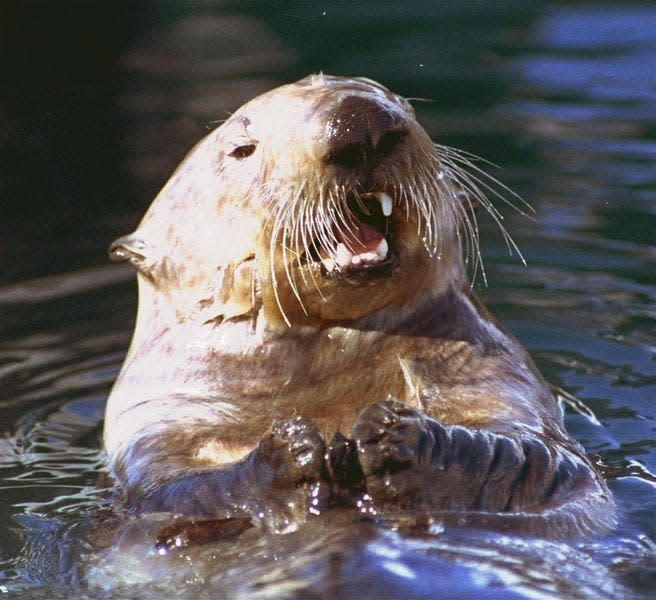Gray wolves turn to new food source after killing off deer in Pleasant Island, Alaska

For many years the islands off Alaska’s coast have enjoyed a relatively steady balance between small critters and large, prey species and predators.
This was especially true for the largest predator species, the gray wolves (Canis lupus), and the native deer species, the Sitka deer (or Sitka black-tailed deer, Odocoileus hemionus sitkensis) which is a subspecies of the mule deer. The Sitka deer are similar to the Colombian black-tailed deer, another mule deer subspecies.
However, all of that has apparently changed during the past two years. The wolf population has remained relatively stable on the high side while the deer population has suffered from severe winter conditions and over-harvesting by the wolves. For now there are not enough deer to satisfy the wolves's hunger and maintain their current population.
But wolves, always opportunists when it comes to their food, are multi-prey species if nothing else. If their primary food source is “absent” and there is another potential “food” source, they will utilize it.
And, in the case of Pleasant Island, Alaska, there is another means of quenching the hunger pangs. Sea otters often come ashore in large numbers there, primarily to preen and sun themselves and also to give birth. And that species has recently, out of necessity, become the primary food source for the island’s wolves.
Scientists began tracking wolves on the island with GPS collars in 2012. By analyzing their scat (feces) in 2017 they determined that deer were the main food source, making it 75% of their diet.
Sea otters made up the remaining 25%. There are no other animal species on the island that might fill in as a supplemental food source.
The big problem
The wolves have killed so many deer between 2015-17 that they really had no choice other than to switch to more plentiful sea otters that live along the island’s shore as their primary prey species.
It seems the increased winter deer mortality due not only to the severe winters and also combined with low spring fawn survival and the continued wolf depredation on the herd, forced this switch. It was either change their primary prey species or starve.
And anyone who knows anything about wolves also understands that they are survivors. They will not starve unless there is absolutely no huntable or “find-able” food source available.
What about the sea otters? Can they survive this kind of depredation by a species that many claim are at the apex of virtually all North American predators?
The gray wolf is definitely a major threat. If it is a single or lone wolf, it is a super cagey predator to contend with wherever food source might be found. And when a pack of wolves are working together, no prey species, including moose, elk or deer, is safe from their attack.
Not all is lost for the sea otters
However, there are two primary facts concerning sea otters that are also important to understand. The first is that their overall population across their entire range is high.
It may be as numerous today as it was when the original Russian trappers discovered them way back when. Some experts on this species, and many abalone seekers, claim their population has probably never been higher.
The second is that they can be found on many other islands (besides Pleasant Island) as well as many stretches of Alaskan and Canadian mainland, along with other more southerly areas, where they “haul out” to rest and/or birth their youngsters. What happens on this island will probably not have any noticeable effect on their overall population.
The experts working on the Pleasant Island “problem” are in general agreement that it is highly unusual that an apex predator is praying on another apex predator. Yes, sea otters are the apex predator in most of their range.
Baby deer: How these 'tiny balls of energy' are raised by their mother
Want to help newborn wildlife? Then leave it alone
It is only in areas where both the otter and large ocean predators such as Orcas and some shark species also inhabit. And the large majority of otters are (almost) strictly near-shore hunters.
Of course they also follow their favorite meal, the abalone. And occasionally that takes them into deeper waters where sharks might linger, but they are fast and agile swimmers and more often escape any danger.
Taking a closer look
Researchers with the Alaska Department of Fish and Game, along with their counterparts at Oregon State University, have an ongoing study on the wolf pack on Pleasant Island as well as the adjacent land. This study began in 2015.

They are, however, surprised that the otters have become the principle prey for the wolves, according to my phone call to Taal Levi, associate professor at Oregon State.
Sea otters were probably in the area of Canadian and Alaska shores and islands for more than 4,000 years, possibly a lot more. They were probably off the western U.S. coast for at least the same amount of years. Scientists figure they may have been in that entire area for a lot longer, but geologic records are scarce to non-existent along that entire region due to geologic activity that is almost always present.
It was only with the advent of humans and their all-consuming greed for those lush fur pelts that these incredible animals were literally sent to the brink of extinction. Shortly after the U.S. obtained title to what is now Alaska, and scientific management was instituted, that the sea otter species began a literal “rebirth” to the population it now enjoys.
What about wolves? Science can prove their habitation of the far West Coast for the past 15,000 years (possibly longer, but without tangible records). Wherever they are found with few exceptions they are the apex predator. They may have been almost exterminated in the U.S., but their Alaskan and Canadian population was always robust.
And they are definitely survivors, just as the situation on Pleasant Island demonstrates.
Len Lisenbee is the Daily Messenger’s Outdoor Writer. Contact him at lisenbee@frontiernet.net
This article originally appeared on MPNnow: Gray wolves find new food source after killing off deer in Alaska
